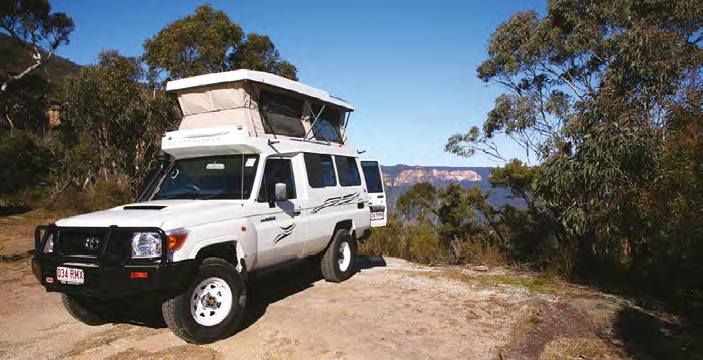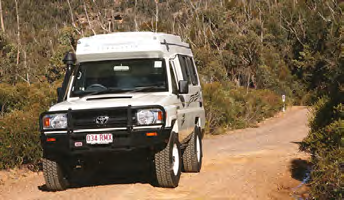
Getting off the beaten track is something that can easily be done in Australia. There’s almost no end of destinations that offer stunning landscapes, quiet campsites away from the crowd or just simply the fun and challenge of driving along rough road tracks. However, leaving the beaten track in many cases does require a four-wheel-drive vehicle.
One of the disadvantages of a motorhome (and there are very few of course) is that not many are built for four-wheel-drive travel. For the most part, serious off-road travel is restricted to those motorhomes built on something like a Toyota 4X4 HiLux or a 4X4 Mercedes-Benz Sprinter van.
There are other options like a MAN or Unimog 4X4 but they are for those with a very generous budget because larger 4WD motorhomes are something of a specialist item. It is not necessarily a disadvantage having a smaller vehicle – they are often better suited to narrow, heavily corrugated or undulating bush tracks.
An option for those with a 2WD motorhome, who desire a bit of off-road exploration time is to rent a 4WD camper. KEA no longer has those available but our sister hirer, Britz, certainly does. We reckon they are just great for those who occasionally like to get off-road.
For those who do own a 4WD or AWD motorhome we have several tips before you set out, especially if your rig is new and/or you are relatively inexperienced in four-wheel drive travel.
The first is to fully understand your vehicle. Because of a number of factors like height, width and weight, motorhomes for the most part are not going to have the same capabilities as a conventional 4WD. It might sound like a motherhood statement but we know from experience that there are travellers who really don’t understand what their vehicle is capable of and, conversely, those who think it’s capable of anything. Depending on the locality of travel, recovery gear like snatch straps and sand ladders/mats are also considerations.
Before planning any lengthy travel, a few short shakedown trips are certainly recommended. These can show fairly easily the strengths and shortcomings of vehicle and drivers.
One very effective way of getting a handle on vehicle capabilities is to undertake an off-road training course. These are available from a number of training organisations and are highly recommended for not only getting a good handle on four-wheel driving but also understanding what to do in the event of getting bogged.
We have attended one such training event and reckon that they are even good for conventional 2WD motorhome owners who like to spend their time getting along bush tracks. We were amazed when one of the instructors demonstrated what could be achieved by learning a few simple driving tricks. Additionally, for those with front-wheel-drive vehicles which are often criticised for their poor traction abilities are often better than current perceptions would have them.
A brief study of the 4WD accessory market will reveal any number of goodies that can assist four-wheel travel but they all add weight and a training course can certainly give an understanding of what recovery gear might need to be carried.
Most motorhomes are fitted with conventional light truck radial tyres. However, there are some tread patterns (usually more expensive) that are better suited to off-road travel. Of course, it does depend on just how much rough road travel is being planned.
One item that most motorhomers do not carry is an air compressor. Traction in sand and mud can be improved no end by lowering tyre pressures, even with conventional tyres. By lowering the tyre pressure, it simply increases the tyre ‘footprint’ and hence the traction. Of course the air compressor is required when reverting to normal on road tyre pressure again. Front-wheel-drive vehicle owners might like to know that this can also apply to them too. Some owners have their tyres set at too high a pressure and they can be set slightly lower to suit both on- and off-road conditions.

One of the other great options for off-road travel is a tagalong trip. We reckon that it’s not particularly advisable to travel alone in serious four-wheeldrive country so travelling with someone else is certainly a good idea. Apart from anything else, recovery gear can be shared. Group travel, like with a tagalong trip, not only adds travelling companions but an experienced off-roader team leader as well. Shared experiences can add greatly to understanding off-road travel.
Off-road travel in a motorhome isn’t for everyone but by having the right vehicle and learning a few simple tips and techniques, it can easily be enjoyed by the keen traveller without risk to either the passengers or the vehicle.
Category: Features
Written: Mon 01 Jun 2015
Printed: June, 2015
Published By: